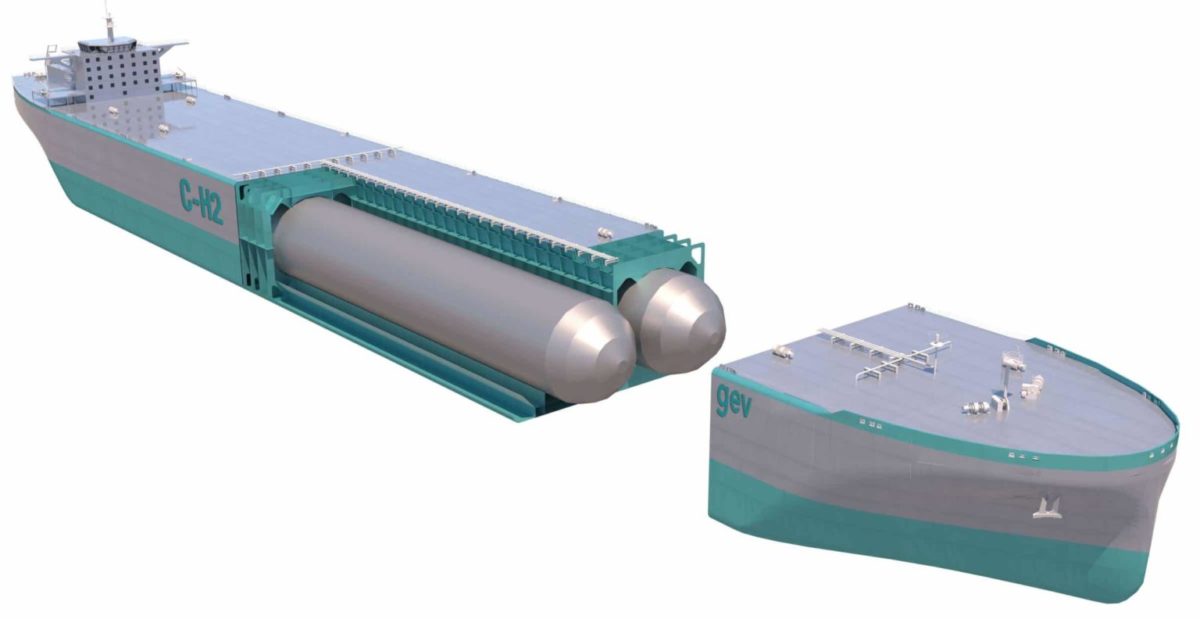Global Energy Ventures (GEV) says it now has the confidence to “rapidly progress” the development of its compressed hydrogen C-H2 Ship to the next phase.
The “world first” vessel design, which has already been patented, will be able to transport 2,000 tons of compressed hydrogen. GEV, a marine transport company based in Western Australia, says the study confirms that it can deliver the ship itself and a full zero-emissions compressed hydrogen (C-H2) supply chain with minimal barriers. It expects commercialization within the next five years.
“The idea is that the C-H2 supply chain will be commercially available before the alternative proposals of large-scale liquefaction of hydrogen or ammonia,” GEV said.
This would mark a significant achievement, as the delivery of green hydrogen via zero-emissions transport options has been front of mind for many potential importers, according to Smart Energy Council consultant Scott Hamilton.
GEV Executive Director Martin Carolan said that C-H2 will become a “game-changing solution” for the hydrogen economy. He expects it to deliver a “timely and energy efficient ‘port to port’ zero emission supply chain for green hydrogen” in Australia, destined for markets throughout the Asia-Pacific region.
The C-H2 Ship can carry up to 2,000 tons of hydrogen in its containment system. The company has said that its design “eliminates the requirement for onsite storage, as the C-H2 Ship is itself the storage.” It has described its push to develop a compressed hydrogen ship as a “natural progression to meet a market requirement for the storage and marine transportation of hydrogen.”
GEV said the scoping study shows that its compressed hydrogen supply chain is economically “very competitive” compared to shipping liquefied hydrogen or ammonia at distances of 2,000 nautical miles (3,700 km). As the company noted, that is roughly the distance between northern Australia and Singapore. Its C-H2 shipping remains competitive to 4,500 nautical miles, which is the distance from Australia to Japan, South Korea, and China.
Next steps
The company filed a U.S. patent application filed for its C-H2 ship in December, and is now working on a detailed marketing plan for the C-H2 supply chain as a “competitive and viable alternative for the ‘port to port’ export of green hydrogen from Australia.” The company also plans to develop its own green hydrogen export project to support the construction of a pilot scale C-H2 Ship. If all goes according to plan on the approvals front, the company is confident that it will reach its target of Final Class Approval in 2022.
In terms of technical risk, the scoping study showed that GEV’s compressed hydrogen supply chain has a lower technical risk compared to liquified hydrogen and ammonia.
“The C-H2 supply chain consists of compressors, pipework, loading infrastructure and C-H2 Ship Fleet. Hydrogen compressors (designed for pressure as high as 700 bar) have been in operation for decades with the associated piping and loading equipment having already been developed for various onshore applications,” the company said.
GEV’s scoping study was based on the notion that it would be provided a constant supply of green hydrogen by a third party at a price of $2/kg (AUD 2.6/kg) at a pressure of 20 bar. It also assumed that port facilities at both the supply and customer points will be made available at no cost for all three supply chains.
This content is protected by copyright and may not be reused. If you want to cooperate with us and would like to reuse some of our content, please contact: editors@pv-magazine.com.




By submitting this form you agree to pv magazine using your data for the purposes of publishing your comment.
Your personal data will only be disclosed or otherwise transmitted to third parties for the purposes of spam filtering or if this is necessary for technical maintenance of the website. Any other transfer to third parties will not take place unless this is justified on the basis of applicable data protection regulations or if pv magazine is legally obliged to do so.
You may revoke this consent at any time with effect for the future, in which case your personal data will be deleted immediately. Otherwise, your data will be deleted if pv magazine has processed your request or the purpose of data storage is fulfilled.
Further information on data privacy can be found in our Data Protection Policy.